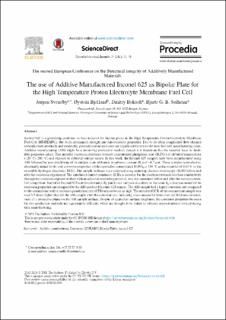| dc.contributor.author | Svendby, Jørgen | |
| dc.contributor.author | Bjelland, Øystein | |
| dc.contributor.author | Bokach, Dmitry | |
| dc.contributor.author | Solheim, Bjarte G. | |
| dc.date.accessioned | 2022-09-26T11:22:33Z | |
| dc.date.available | 2022-09-26T11:22:33Z | |
| dc.date.created | 2022-01-05T09:29:42Z | |
| dc.date.issued | 2021 | |
| dc.identifier.citation | Procedia Structural Integrity. 2021, 34 51-58. | en_US |
| dc.identifier.issn | 2452-3216 | |
| dc.identifier.uri | https://hdl.handle.net/11250/3021278 | |
| dc.description.abstract | Inconel 625 is a promising candidate as base material for bipolar plates in the High Temperature Proton Electrolyte Membrane Fuel Cell (HT-PEMFC), due to its mechanical strength and anti-corrosive properties. Due to its often complicated flow channel networks both internally and externally, production time and costs are significant factors to the total fuel cell manufacturing costs. Additive manufacturing (AM) might be a promising production method, though it is important that the material have its desirable properties intact. This includes corrosion resistance towards concentrated phosphoric acid (H3PO4) at elevated temperatures (120 °C- 200 °C) and exposed to different voltage values. In this work, flat Inconel 625 samples have been manufactured using AM followed by post-machining of its surface to an arithmetic roughness average (Ra) of ~0.3 |j.m. These samples were electro-chemically tested for its anti-corrosive properties while exposed to concentrated H3PO4 at 150 °C and a potential of 0.65 V vs the reversible hydrogen electrode (RHE). The sample surfaces were analysed using scanning electron microscopy (SEM) before and after the corrosion experiment. The interfacial contact resistance (ICR), a measure for the resistance towards electron conductivity through the corrosion-exposed surface with an adjacent conducting material, was also measured before and after the corrosion tests. For comparison, hot rolled Inconel 625 sample commercially purchased and post-machined to the same Ra-value was tested for its corrosion properties and compared to the AM-produced Inconel 625 sample. The AM-sample had a higher corrosion rate compared to the commercial with a corrosion penetration rate (CPR) almost twice as high. The measured ICR of the commercial sample was over 3.5 times higher than for the AM-sample after the corrosion test, indicating a less successful formation and thickness development of a protective phase on the AM-sample surface. Despite of equivalent surface roughness, the corrosion properties between the two production methods are significantly different, which are thought to be linked to different microstructures formed during their manufacturing. | en_US |
| dc.language.iso | eng | en_US |
| dc.publisher | Elsevier | en_US |
| dc.rights | Attribution-NonCommercial-NoDerivatives 4.0 Internasjonal | * |
| dc.rights.uri | http://creativecommons.org/licenses/by-nc-nd/4.0/deed.no | * |
| dc.title | The use of Additive Manufactured Inconel 625 as Bipolar Plate for the High Temperature Proton Electrolyte Membrane Fuel Cell | en_US |
| dc.type | Journal article | en_US |
| dc.type | Peer reviewed | en_US |
| dc.description.version | publishedVersion | en_US |
| dc.source.pagenumber | 51-58 | en_US |
| dc.source.volume | 34 | en_US |
| dc.source.journal | Procedia Structural Integrity | en_US |
| dc.identifier.doi | 10.1016/j.prostr.2021.12.008 | |
| dc.identifier.cristin | 1974876 | |
| cristin.ispublished | true | |
| cristin.fulltext | postprint | |
| cristin.qualitycode | 1 | |

